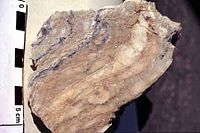Cerussite
| Cerussite | |
 Sample of cerussite-bearing quartzite | |
| General | |
|---|---|
| Category | Carbonate mineral |
| Chemical formula | Lead carbonate: PbCO3 |
| Identification | |
| Color | Colorless, white, gray, blue, or green |
| Crystal habit | Massive granular, reticulate, tabular to equant crystals |
| Crystal system | Orthorhombic - Dipyramidal (2/m 2/m 2/m) |
| Twinning | Simple or cyclic contact twins |
| Cleavage | Good [110] and [021] |
| Fracture | Brittle conchoidal |
| Mohs Scalehardness | 3 to 3.5 |
| Luster | Adamantine, vitreous, resinous |
| Streak | White |
| Diaphaneity | Transparent to translucent |
| Specific gravity | 6.53 - 6.57 |
| Optical properties | Biaxial (-) |
| Refractive index | nα = 1..803 nβ = 2.074 nγ = 2.076 |
| Birefringence | δ = 0.273 |
| Other characteristics | May fluoresce yellow under LW UV |
| References | [1][2] |
Cerussite (also known as lead carbonate or white lead ore) is a mineral consisting of leadcarbonate (PbCO3), and an important ore of lead. The name is from the Latin cerussa, white lead. Cerussa nativa was mentioned by Conrad Gessner in 1565, and in 1832 F. S. Beudantapplied the name cruse to the mineral, whilst the present form, cerussite, is due to W. Haidinger (1845). Miners' names in early use were lead-spar and white-lead-ore.
Cerussite crystallizes in the orthorhombic system and is isomorphous with aragonite. Like aragonite it is very frequently twinned, the compound crystals being pseudo-hexagonal in form. Three crystals are usually twinned together on two faces of the prism, producing six-rayed stellate groups with the individual crystals intercrossing at angles of nearly 60°. Crystals are of frequent occurrence and they usually have very bright and smooth faces. The mineral also occurs in compact granular masses, and sometimes in fibrous forms. The mineral is usually colorless or white, sometimes grey or greenish in tint and varies from transparent to translucent with an adamantine lustre. It is very brittle, and has a conchoidal fracture. It has aMohs hardness of 3 to 3.75 and a specific gravity of 6.5. A variety containing 7 % of zinc carbonate, replacing lead carbonate, is known as iglesiasite, from Iglesias in Sardinia, where it is found.
The mineral may be readily recognized by its characteristic twinning, in conjunction with the adamantine lustre and high specific gravity. It dissolves with effervescence in dilute nitric acid. A blowpipe test will cause it to fuse very readily, and gives indications for lead.
Finely crystallized specimens have been obtained from the Friedrichssegen mine in Lahnsteinnear Nassau, Johanngeorgenstadt in Saxony, Mies in Bohemia, Phoenixville in Pennsylvania,Broken Hill, New South Wales; and several other localities. Delicate acicular crystals of considerable length were found long ago in the Pentire Glaze mine near St Minver in Cornwall. It is often found in considerable quantities, and contains as much as 77.5% of lead.
Lead(II) carbonate is practically insoluble in neutral water (solubility product [Pb2+][CO32-] ≈ 1.5x10-13 at 25 °C), but will dissolve in dilute acids.
Commercial uses
"White lead" is the key ingredient in (now discontinued) lead paints. Ingestion of lead-based paint chips is the most common cause of lead poisoning in children.[3]
Both "white lead" and lead acetate have been used in cosmetics throughout history, though this practice has ceased in Western countries.[4]


No comments:
Post a Comment